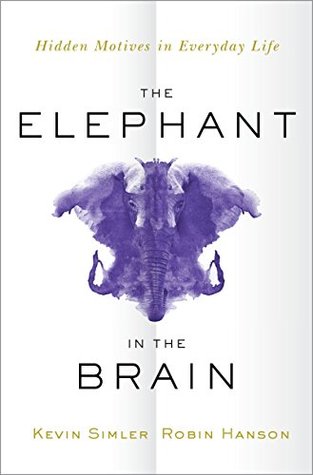More on this book
Community
Kindle Notes & Highlights
Even more dramatic examples of rationalization can be elicited from patients suffering from disability denial,7 a rare disorder that occasionally results from a right-hemisphere stroke. In a typical case, the stroke will leave the patient’s left arm paralyzed, but—here’s the weird part—the patient will completely deny that anything is wrong with his arm, and will manufacture all sorts of strange (counterfeit) excuses for why it’s just sitting there, limp and lifeless.
the Chinese officials who banned puns in 2014
when articles previously published in a journal were resubmitted soon afterward with new obscure names and institutions, only 10 percent of them were noticed as having been published before, and of the remaining 90 percent, only 10 percent were accepted under the new names.
Griskevicius and his team asked subjects to consider buying green or non-green products in two different shopping scenarios. One group was asked to imagine making the purchase online, in the privacy of their homes, while another group was asked to imagine making the purchase in public, out at a store. What they found is that, when subjects are primed with a status motive, they show a stronger preference for green products when shopping in public, and a weaker preference for green products when shopping online. Clearly their motive isn’t just to help the environment, but also to be seen as
...more
As Bertrand Russell is often reported to have said, “The mark of a civilized man is the capacity to read a column of numbers and weep,”
Individual students can expect their incomes to rise roughly 8 to 12 percent for each additional year of school they complete. Nations, however, can expect their incomes to rise by only 1 to 3 percent for each additional year of school completed by their citizens on average.
Caplan, for example, estimates that signaling is responsible for up to 80 percent of the total value of education.
Countries have made large investments in state primary education systems when they face military rivals or threats from their neighbors.
Of the 34 of these studies that were later tested by other researchers, only 20 were confirmed.
when the government published risk-adjusted hospital death rates between 1986 and 1992, hospitals with twice the risk-adjusted death rates saw their admissions fall by only 0.8 percent.47 In contrast, a single high-profile news story about an untoward death at a hospital resulted in a 9 percent drop in patient admissions at that hospital.
Compared to their secular counterparts, religious people tend to smoke less,16 donate and volunteer more,17 have more social connections,18 get and stay married more,19 and have more kids.20 They also live longer,21 earn more money,22 experience less depression,23 and report greater happiness and fulfillment in their lives.24 These are only correlations, yes, which exist to some extent because healthier, better-adjusted people choose to join religions. Still, it’s hard to square the data with the notion that religions are, by and large, harmful to their members.
Emil Pfeiffer stenbøg liked this
80 percent of people chose to award a scholarship to a member of their favored political party, even when another applicant had better grades. In fact, this political favoritism was stronger than racial favoritism.
Among sociology professors, a quarter admitted that they would favor a Democrat over a Republican for a job in their department.
This effect is larger than the effect for women, who also seem to face discrimination in academic jobs.


